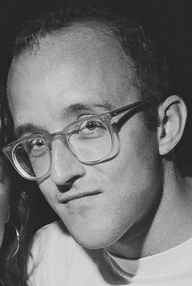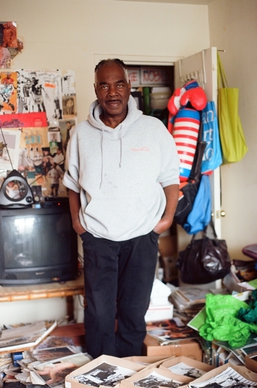Related Research Articles

Keith Allen Haring was an American artist whose pop art emerged from the New York City graffiti subculture of the 1980s. His animated imagery has "become a widely recognized visual language". Much of his work includes sexual allusions that turned into social activism by using the images to advocate for safe sex and AIDS awareness. In addition to solo gallery exhibitions, he participated in renowned national and international group shows such as documenta in Kassel, the Whitney Biennial in New York, the São Paulo Biennial, and the Venice Biennale. The Whitney Museum held a retrospective of his art in 1997.

Ross Bleckner is an American artist. He currently lives and works in New York City. His artistic focus is on painting, and he held his first solo exhibition in 1975. Some of his art work reflected on the AIDS epidemic.

The red ribbon, as an awareness ribbon, is used as the symbol for the solidarity of people living with HIV/AIDS, and for the awareness and prevention of drug abuse and drunk driving.

The World AIDS Museum and Educational Center, located at 1350 E Sunrise Blvd. in Fort Lauderdale, Florida, opened on May 15, 2014.

José Esteban Muñoz was a Cuban American academic in the fields of performance studies, visual culture, queer theory, cultural studies, and critical theory. His first book, Disidentifications: Queers of Color and the Performance of Politics (1999) examines the performance, activism, and survival of queer people of color through the optics of performance studies. His second book, Cruising Utopia: the Then and There of Queer Futurity, was published by NYU Press in 2009. Muñoz was Professor in, and former Chair of, the Department of Performance Studies at New York University's Tisch School of the Arts. Muñoz was the recipient of the Duke Endowment Fellowship (1989) and the Penn State University Fellowship (1997). He was also affiliated with the Modern Language Association, American Studies Association, and the College Art Association.
Elizabeth Joy Peyton is an American contemporary artist working primarily in painting, drawing, and printmaking. Best known for figures from her own life and those beyond it, including close friends, historical personae, and icons of contemporary culture, Peyton's portraits have regularly featured artists, writers, musicians, and actors.
The Southland Art Foundation, established in 1995, is a Southland, New Zealand, art foundation that provides funding for a variety of art programs and scholarships for New Zealand artists. It was the successor to the Trustbank Southland Art Foundation, created by former Southland Museum and Art Gallery Chairman, Dr Alf Poole CBE and former Southland Museum and Art Gallery Director, Russell Beck.
The Institute of Cultural Inquiry (ICI) is a non-profit organization located in Los Angeles, California. Its mission is "to educate the public about the visual methods used in society to describe and discuss cultural phenomena." The ICI has sponsored art research, art creation in multiple media, projects, symposia, and publications related to its major areas of interest, which include the AIDS pandemic, obsolete technologies, and marginal cultural figures.

Indrani Pal-Chaudhuri is an Indian artist, film director, and photographer.
Brett Reichman is a painter and Professor at the San Francisco Art Institute where he teaches in both the graduate and undergraduate programs. Born in Pittsburgh, Pennsylvania, he has lived and worked in San Francisco since 1984.
David McDiarmid (1952–1995) was an artist, designer and political activist, recognised for his prominent and sustained artistic engagement in issues relating to gay male identity and HIV/AIDS. He is also known for his involvement in the gay liberation movement of the early 1970s, when he was the first person arrested at a gay rights protest in Australia, as well as his artistic direction of the Sydney Gay and Lesbian Mardi Gras. From its inception, McDiarmid's art career encompassed, as both subject and inspiration, gay male sexuality, politics and urban subcultures. His creative techniques included: collage, painting, drawing, calligraphy, mosaic, installation, various forms of print-making, sculpture and artist's books. He was a graphic designer, designer and fabric painter for women's and men's fashion, and an artist and creative director for the Sydney Gay and Lesbian Mardi Gras street parades.

Artists Space is a non-profit art gallery and arts organization first established at 155 Wooster Street in Soho, New York City. Founded in 1972 by Irving Sandler and Trudie Grace and funded by the New York State Council on the Arts (NYSCA), Artists Space provided an alternative support structure for young, emerging artists, separate from the museum and commercial gallery system. Artists Space has historically been engaged in critical dialogues surrounding institutional critique, racism, the AIDS crisis, and Occupy Wall Street.

The AIDS pandemic began in the early 1980s and brought with it a surge of emotions from the public: they were afraid, angry, fearful and defiant. The arrival of AIDS also brought with it a condemnation of the LGBT community. These emotions, along with the view on the LGBT community, paved the way for a new generation of artists. Artists involved in AIDS activist organizations had the ideology that while art could never save lives as science could, it may be able to deliver a message. Art of the AIDS crisis typically sought to make a sociopolitical statement, stress the medical impact of the disease, or express feelings of longing and loss. The ideologies were present in conceptions of art in the 1980s and are still pertinent to reception of art today as well. Elizabeth Taylor, for example, spoke at a benefit for AIDS involving artwork, emphasizing its importance to activism in that "art lives on forever". This comment articulates the ability of artwork from this time to teach and impact contemporary audiences, post-crisis. This page examines the efforts of artists, art collectives, and art movements to make sense of such an urgent pandemic in American society.
William "Bill" R. Olander was an American senior curator at the New Museum of Contemporary Art in New York City. He previously worked as curator and director of the Allen Memorial Art Museum. He was a co-founder of the arts organization Visual AIDS.
Robert Farber was an American actor and artist.
Nadema Ivania Agard, who also uses the name Winyan Luta Red Woman, is an American visual artist, educator, illustrator, poet, storyteller, museum professional and an activist for Indigenous rights. Agard also works as a consultant on repatriation, multicultural arts, and Native American arts and cultures. Additionally, Agard owns and directs an art production and consulting enterprise, Red Earth Studio.
Visual AIDS is an art organization based in New York City. Started in 1988, it is one of the first initiatives to record the impact of the AIDS pandemic on the artistic community. Art institutions and AIDS-related communities co-developed projects like Day Without Art, Night Without Light, The Banner Project, Postcards from the Edge, and The Ribbon Project. Artists include...

Frederick Weston (1946–2020) was an American interdisciplinary artist. Self-taught, he worked in collage, drawing, sculpture, photography, performance, and creative writing. He was raised in Detroit, Michigan and moved to New York City in the mid-1970s. Over the course of his time in New York, he developed a vast, encyclopedic archive of images and ephemera related to fashion, the body, advertising, AIDS, and queer subjects through his various jobs and social presence in hustler bars and gay nightlife. His early collages and photography, which often utilized likenesses of patrons, highlighted the social and communal nature of such institutions. Continuing this theme, in the mid-1990s, he became co-founder of guerrilla artist group Underground Railroad, which produced street art and outdoor installations. In his lifetime, he exhibited to small audiences in non-traditional art spaces and only in the last two years of his life did his work become widely known and appreciated in urban art circles.

Todos Juntos Podemos Parar el SIDA is a mural created by American artist and social activist Keith Haring in 1989. The mural was painted to raise awareness to the AIDS epidemic. It is located next to the Museu d'Art Contemporani de Barcelona museum in the El Raval neighborhood of Barcelona.

Patrick Webb is an American artist who has portrayed contemporary queer experience through representational narrative paintings. He is best known for his "Punchinello" paintings, begun in the early 1990s, which feature a gay "everyman" based on the Italian commedia dell'arte stock character, Pulcinella. Art historians Jonathan D. Katz and Jonathan Weinberg place Webb among artists who that gave voice to the loss and grief associated with the AIDS epidemic by looking beyond the message-heavy activist art and anti-expressive postmodernism of the 1980s to reinvigorated art-historical narrative traditions. Writers note his work for its classically influenced technique and pathos in fleshing out fears, fantasies, experiences and social dichotomies between self and Other, individual and collective, personal and sociocultural. He draws on pictorial strategies from old masters as well as modern artists such as Balthus, Jacob Lawrence, Philip Guston and the magic realist Jared French, building scenarios out of architecturally structured compositions, carefully placed elements and precise gestures.
References
- 1 2 Rob., Baker (1994). The art of AIDS . New York: Continuum. pp. 164-165. ISBN 082640653X. OCLC 30318553.
- ↑ Robinet, Jane-Ellen (2008-09-08). "Carnegie Online". Archived from the original on 2008-09-08. Retrieved 2021-12-01.
- 1 2 3 Sanchez, Charles (2019-11-21). "'Still Beginning': 30 Years of 'Day With(out) Art'". The Body. Archived from the original on 2019-11-22. Retrieved 2021-12-01.
- ↑ Yarrow, Andrew L. (1989-11-29). "'Day Without Art' to Mourn Losses From AIDS". The New York Times. ISSN 0362-4331 . Retrieved 2021-12-01.
- ↑ AIDS, Visual. "The video is a remembrance within a remembrance: to Pedro Zamora and to José Esteban Muñoz". Visual AIDS. Archived from the original on 2016-06-23. Retrieved 2016-04-27.
- 1 2 "Projects 31: A Space without Art | MoMA". The Museum of Modern Art. Retrieved 2021-12-01.
- ↑ "Guggenheim A Day Without Art Exhibition | Gabellini Sheppard". GabelliniSheppard. Archived from the original on 2022-05-17. Retrieved 2021-12-01.
- ↑ Davidow, Jackson (2020-11-30). "Museums and Mourning in COVID-19". Boston Review. Archived from the original on 2021-12-01. Retrieved 2021-12-01.
- ↑ "TRANSMISSIONS / Day With(out) Art 2020".
- ↑ "Visual AIDS | Day With(out) Art 2020: TRANSMISSIONS".